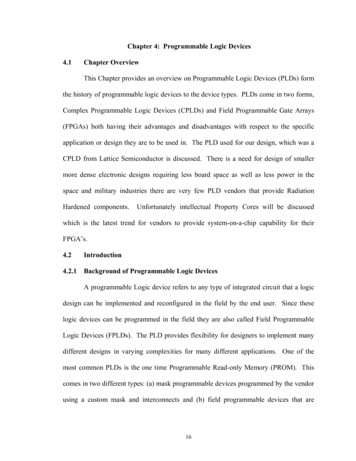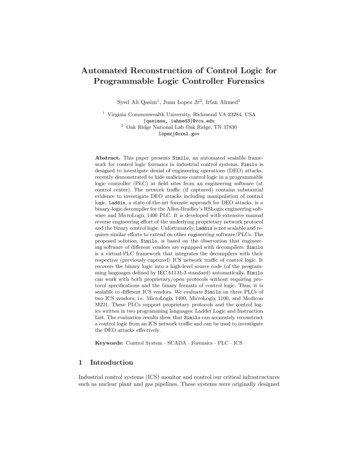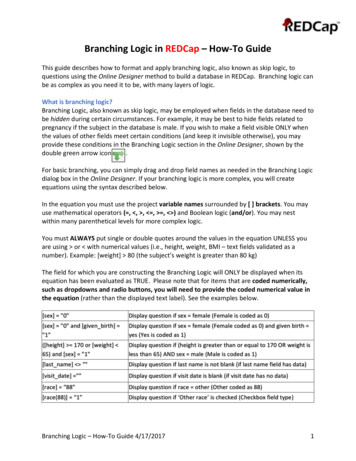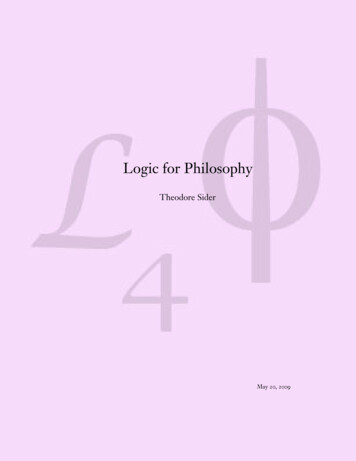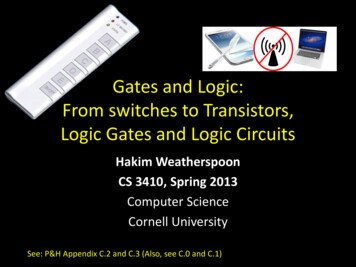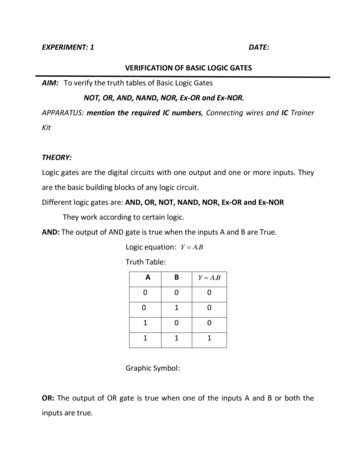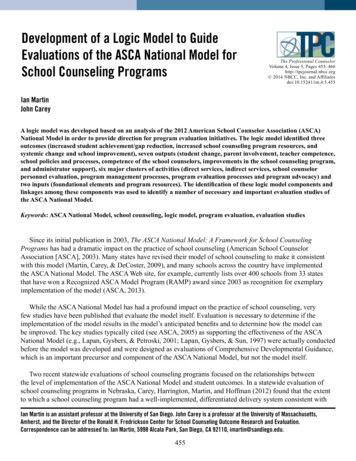
Transcription
Development of a Logic Model to GuideEvaluations of the ASCA National Model forSchool Counseling ProgramsThe Professional CounselorVolume 4, Issue 5, Pages 455–466http://tpcjournal.nbcc.org 2014 NBCC, Inc. and Affiliatesdoi:10.15241/im.4.5.455Ian MartinJohn CareyA logic model was developed based on an analysis of the 2012 American School Counselor Association (ASCA)National Model in order to provide direction for program evaluation initiatives. The logic model identified threeoutcomes (increased student achievement/gap reduction, increased school counseling program resources, andsystemic change and school improvement), seven outputs (student change, parent involvement, teacher competence,school policies and processes, competence of the school counselors, improvements in the school counseling program,and administrator support), six major clusters of activities (direct services, indirect services, school counselorpersonnel evaluation, program management processes, program evaluation processes and program advocacy) andtwo inputs (foundational elements and program resources). The identification of these logic model components andlinkages among these components was used to identify a number of necessary and important evaluation studies ofthe ASCA National Model.Keywords: ASCA National Model, school counseling, logic model, program evaluation, evaluation studiesSince its initial publication in 2003, The ASCA National Model: A Framework for School CounselingPrograms has had a dramatic impact on the practice of school counseling (American School CounselorAssociation [ASCA], 2003). Many states have revised their model of school counseling to make it consistentwith this model (Martin, Carey, & DeCoster, 2009), and many schools across the country have implementedthe ASCA National Model. The ASCA Web site, for example, currently lists over 400 schools from 33 statesthat have won a Recognized ASCA Model Program (RAMP) award since 2003 as recognition for exemplaryimplementation of the model (ASCA, 2013).While the ASCA National Model has had a profound impact on the practice of school counseling, veryfew studies have been published that evaluate the model itself. Evaluation is necessary to determine if theimplementation of the model results in the model’s anticipated benefits and to determine how the model canbe improved. The key studies typically cited (see ASCA, 2005) as supporting the effectiveness of the ASCANational Model (e.g., Lapan, Gysbers, & Petroski, 2001; Lapan, Gysbers, & Sun, 1997) were actually conductedbefore the model was developed and were designed as evaluations of Comprehensive Developmental Guidance,which is an important precursor and component of the ASCA National Model, but not the model itself.Two recent statewide evaluations of school counseling programs focused on the relationships betweenthe level of implementation of the ASCA National Model and student outcomes. In a statewide evaluation ofschool counseling programs in Nebraska, Carey, Harrington, Martin, and Hoffman (2012) found that the extentto which a school counseling program had a well-implemented, differentiated delivery system consistent withIan Martin is an assistant professor at the University of San Diego. John Carey is a professor at the University of Massachusetts,Amherst, and the Director of the Ronald H. Fredrickson Center for School Counseling Outcome Research and Evaluation.Correspondence can be addressed to: Ian Martin, 5998 Alcala Park, San Diego, CA 92110, imartin@sandiego.edu.455
The Professional Counselor\Volume 4, Issue 5practices advocated by the ASCA National Model was associated with lower suspension rates, lower disciplineincident rates, higher attendance rates, higher math proficiency and higher reading proficiency. These resultssuggest that model implementation is associated with increased student engagement, fewer disciplinaryproblems and higher student achievement. In a similar statewide evaluation study in Utah, Carey, Harrington,Martin, and Stevens (2012) found that the extent to which the school counseling program had a programmaticorientation, similar to that advocated in the ASCA National Model, was associated with both higher averageACT scores and a higher number of students taking the ACT. This suggests that model implementation isassociated with both increased achievement and a broadening of student interest in college. While these studiessuggest that benefits to students are associated with the implementation of the ASCA National Model, additionalevaluations are necessary that use stronger (e.g., quasi-experimental and longitudinal) designs and investigatespecific components of the model in order to determine their effectiveness or how they can be improved.There are several possible reasons why the ASCA National Model has not been evaluated extensively.The school counseling field as a whole has struggled with general evaluation issues. For example, questionshave been raised regarding the effectiveness of practitioner training in evaluation (Astramovich, Coker, &Hoskins, 2005; Heppner, Kivlighan, & Wampold, 1999; Sexton, Whiston, Bleuer, & Walz, 1997; Trevisan,2000); practitioners have cited lack of time, evaluation resources and administrative support as major barriersto evaluation (Loesch, 2001; Lusky & Hayes, 2001); and some practitioners have feared that poor evaluationresults may negatively impact their program credibility (Isaacs, 2003; Schmidt, 1995). Another contributingfactor is that while the importance of evaluation is stressed in the literature, few actual examples of programevaluations and program evaluation results have been published (Astramovich & Coker, 2007; Martin & Carey,2012; Martin et al., 2009; Trevisan, 2002).In addition, there are several features of the ASCA National Model that make evaluations difficult. First, themodel is complex, containing many components grouped into four interrelated, functional subsystems referredto as the foundation, delivery system, management system and accountability system. Second, ASCA createdthe National Model by combining elements of existing models that were developed by different individuals andgroups. For example, the principle influences of the model (ASCA, 2012) are cited as Gysbers and Henderson(2000), Johnson and Johnson (2001) and Myrick (2003). Furthermore, principles and concepts derived fromimportant movements such as the Transforming School Counseling Initiative (Martin, 2002) and evidencebased school counseling (Dimmitt, Carey, & Hatch, 2007) also were incorporated into the model during itsdevelopment. While these preexisting models and movements share some common features, they differ inimportant ways. Elements of these approaches were combined and incorporated into the ASCA National Modelwithout a full integration of their philosophical and theoretical perspectives and principles. Consequently, theASCA National Model does not reflect a single cohesive approach to program organization and management.Instead, it reflects a collection of presumably effective principles and practices that have been applied inschool counseling programs. Third, instruments for measuring important aspects of model implementationare lacking (Clemens, Carey, & Harrington, 2010). Fourth, the theory of action of the ASCA National Modelhas not been fully explicated, so it is difficult to determine what specific benefits are intended to result fromthe implementation of specific elements of the model. For example, it is not entirely clear how changing theperformance evaluation of counselors is related to the desired benefits of the model.In this article, the authors present the results of their work in developing a logic model for the ASCANational Model. Logic modeling is a systematic approach to enabling high-quality program evaluation throughprocesses designed to result in pictorial representations of the theory of action of a program (Frechtling, 2007).Logic modeling surfaces and summarizes the explicit and implicit logic of how a program operates to produceits desired benefits and results. By applying logic modeling to an analysis of the ASCA National Model, the456
The Professional Counselor\Volume 4, Issue 5authors intended to fully explicate the relationships between structures and activities advocated by the modeland their anticipated benefits so that these relationships can be tested in future evaluations of the model.The purpose of this study, therefore, was to develop a useful logic model that describes the workings of theASCA National Model in order to promote its evaluation. More specifically, the purpose was to mine the logicelements, program outcomes and implicit (unstated) assumptions about the relationships between programelements and outcomes. In developing this logic model, the authors followed the processes suggested by theW. K. Kellogg Foundation (2004) and Frechtling (2007). Several different frameworks exist for logic models,but the authors elected to use Frechtling’s framework because it focuses specifically on promoting evaluationof an existing program (as opposed to other possible uses such as program planning). This framework identifiesthe relationships among program inputs, activities, outputs and outcomes. Inputs refer to the resources neededto deliver the program as intended. Activities refer to the actual program components that are expected tobe related to a desired outcome. Outputs refer to the immediate products or results of activities that can beobserved as evidence that the activity was actually completed. Outcomes refer to the desired benefits ofthe program that are expected to occur as a consequence of program activities. The authors’ logic modeldevelopment was guided by four questions:1.2.3.4.What are the essential desired outcomes of the ASCA National Model?What are the essential activities of the ASCA National Model and how do these activities relate to itsoutputs?What are the essential outputs of the ASCA National Model and how do these outputs relate to itsdesired outcomes?What are the essential inputs of the ASCA National Model and how do these inputs relate to itsactivities?MethodsAll analyses in this study were based on the latest edition of the ASCA National Model (ASCA, 2012).In these analyses, every attempt was made to base inferences on the actual language of the model. In someinstances (for example, when it was unclear which outputs were expected to be related to a given activity) theprofessional literature about the ASCA National Model was consulted.Because the authors intended to develop a logic model from an existing program blueprint (rather thandesigning a new program), they began, according to recommended procedures (W. K. Kellogg Foundation,2004), by first identifying outcomes and then working backward to identify activities, then outputs associatedwith activities and finally, inputs.Identification of OutcomesThe authors independently reviewed the ASCA National Model (2012) and identified all elements in themodel. The two authors’ lists of elements (e.g., vision statement, annual agreement with school leaders, indirectservice delivery and curriculum results reports) were merged to create a common list of elements. The authorsthen independently created a series of if, then statements for each element of the model that traced the logicalconnections explicitly stated in the model (or in rare instances, stated in the professional literature about themodel) between the element and a program outcome. In this way, both the desired outcomes of the ASCANational Model and the desired logical linkages between elements and outcomes were identified.During this process, some ASCA National Model elements were included in the same logic sequencebecause they were causally related to each other. For example, both the vision statement and the mission457
The Professional Counselor\Volume 4, Issue 5statement were included in the same logic sequence because a strong vision statement was described asa necessary prerequisite for the development of a strong mission statement. Some ASCA National Modelelements also were included in more than one logical sequence when it was clear that two different outcomeswere intended to occur related to the same element. For example, it was evident that closing-the-gap reportswere intended to result in intervention improvements, leading to better student outcomes and also to apprisingkey stakeholders of school counseling program results, in order to increase support and resources for theprogram.Identification of ActivitiesFrechtling (2007) noted that the choice of the right amount of complexity in portraying the activitiesin a logic model is a critically important factor in a model’s utility. If activities are portrayed in their mostdifferentiated form, the model can be too complex to be useful. If activities are portrayed in their most compactform, the model can lack enough detail to guide evaluation. Therefore, in the present study, the authors decidedto construct several different logic models with different sets of activities that ranged from including all thepreviously identified ASCA National Model elements as activities to including only the four sections of theASCA National Model (i.e., foundation, management system, delivery system and accountability system) asactivities. As neither of the two extreme options proved to be feasible, the authors began clustering ASCANational Model elements and developed six activities, each of which represented a cluster of program elements.Identification of Outputs Related to ActivitiesOutputs are the observable immediate products or deliverables of the logic model’s inputs and activities(Frechtling, 2007). After the authors identified an appropriate level for representing model activities, theygenerated the same level of program outputs. Reexamining the logic sequences, clustering products of identifiedactivities and then creating general output categories from the clustered products accomplished this task. Forexample, the activity known as direct services contained several ASCA National Model products, such as thecurriculum results report, the small-group results report and the closing-the-gap results report (among others),and the resulting output was finally categorized as student change. Ultimately, seven logic model outputs wereidentified through this process to help describe the outputs created by ASCA National Model activities.Identifying the Connections Between Outputs and OutcomesCreating connections between model outputs and outcomes was accomplished by linking the original logicsequences to determine how the ASCA National Model would conceive of outputs as being linked to outcomes.Returning to the above example, the output known as student change, which included such products as resultsreports, was connected to the outcome known as student achievement and gap reduction in several logicsequences. At the conclusion of this process, each output had straightforward links to one or multiple proposedmodel outcomes. Not only was this process useful in identifying links between outputs and outcomes, but it alsofunctioned as an opportunity to test the output categories for conceptual clarity.Identification of Inputs and Connections Between Inputs and ActivitiesThe authors reviewed the ASCA National Model to determine which inputs were necessary to include in thelogic model. They identified two essential types of inputs: foundational elements (conceptual underpinningsdescribed in the foundation section of the ASCA National Model) and program resources (described throughoutthe ASCA National Model). The authors determined that these two types of inputs were necessary for theeffective operation of all six activities.Identifying Other Connections Within the Logic ModelAfter the inputs, activities, outputs, outcomes and the connections between these levels were mapped,the authors again reviewed the logic sequences and the ASCA National Model to determine if any additional458
The Professional Counselor\Volume 4, Issue 5linkages needed to be included in the logic model (see Frechtling, 2007). They evaluated the need for withinlevel linkages (e.g., between two activities) and feedback loops (i.e., where a subsequent component influencesthe nature of preceding components). The authors determined that two within-level and one recursive linkagewere needed.ResultsOutcomesA total of 65 logic sequences were identified for the ASCA National Model sections: foundation (n 7),management system (n 30), delivery system (n 7) and accountability system (n 21). Table 1 containssample logic sequences.Table 1Examples of Logic Sequences Relating ASCA National Model Elements to OutcomesNational ModelSectionLogic SequenceFoundationa. If counselors go through the process of creating a set of shared beliefs, then they will establish a level of mutualunderstanding.b. If counselors establish a level of mutual understanding, then they will be more successful in developing ashared vision for the program.c. If counselors develop a shared vision for the program, then they can develop an effective vision statement.d. If counselors create a vision statement, then they will have the clarity of purpose that is needed to develop amission statement.e. If counselors create a mission statement, then the program will be more focused.f. If the program is better focused, counselors will create a set of program goals, which will enable counselors tospecify how the attainment of the goals should be measured.g. If counselors specify how the attainment of goals should be measured, then effective program evaluation will beconducted.h. If effective program evaluation is conducted, then the program will be continuously improved.i. If the program will be continuously improved, then improved student achievement will result.ManagementSystema. If school counselors create annual agreements with the leader in charge of the school, then the goals andactivities of the counseling program will be more aligned with the goals of the school.b. If the goals and activities of the counseling program are more aligned with the goals of the school, then schoolleaders will recognize the value of the school counseling program.c. If school leaders recognize the value of the school counseling program, then they will commit resources tosupport the program.Delivery Systema. If school counselors engage in indirect services (e.g., consultation and advocacy), then school policies andprocesses will improve.b. If school policies and processes improve, then teachers will develop more competency, and systemic changeand school improvement will occur.AccountabilitySystema. If counselors complete curriculum results reports, then they will have the information they need to demonstratethe effectiveness of developmental and preventative curricular activities.b. If counselors have the information they need to demonstrate the effectiveness of developmental andpreventative curricular activities, then they can communicate their impact to school leaders.c. If school leaders are aware of the impact of developmental and preventative curricular activities, then they willrecognize their value.d. If school leaders recognize the value of developmental and preventative curricular activities, then they willcommit resources to support them.459
The Professional Counselor\Volume 4, Issue 5Forty of these logic sequences terminated with an outcome related to increased student achievement or(relatedly) to a reduction in the achievement gap. Twenty-two sequences terminated with an outcome relatedto an increase in program resources. Only three sequences terminated with an outcome related to systemicchange in the school. From this analysis, the authors concluded that the primary desired outcomes of the ASCANational Model are increased student achievement/gap reduction and increased school counseling programresources. They also concluded that systemic change and school improvement is another desired outcome of theASCA National Model.ActivitiesBased on a clustering of ASCA National Model elements identified previously, six activities were developedfor the logic model. These activities included the following: direct services, indirect services, school counselorpersonnel evaluation, program management processes, program evaluation processes and program advocacyprocesses. Each of these activities represents a cluster of elements within the ASCA National Model. Forexample, the activity known as direct services includes the school counseling core curriculum, individualstudent planning and responsive services. Consequently, the direct services activity represents the spectrum ofservices that would be delivered to students in an ASCA National Model school counseling program.Activities Related to OutputsBased on the clustering of the ASCA National Model products or deliverables around the related logicmodel activities, seven outputs were identified. These outputs included the following: student change, parentinvolvement, teacher competence, school policies and processes, school counselor competence, schoolcounseling program improvements, and administrator support. The outputs represent all of the ASCA NationalModel products generated by model activities and help to collect evidence and determine to what degreean activity was successfully accomplished. In essence, for evaluation purposes, these outputs represent theintermediate outcomes (Dimmitt et al., 2007) of an ASCA National Model program. Activities should result inmeasurable changes in outputs, which in turn should result in measurable changes in outcomes. For example,the output known as student change reflects student changes such as increased academic motivation, increasedproblem-solving skills, enhanced emotional regulation and better interpersonal problem-solving skills; thesechanges lead to the longer-term outcome of student achievement and gap reduction.Connections Between Outputs and OutcomesConnecting the seven ASCA National Model outputs to its outcomes strengthens the logic model byidentifying the hypothesized relationships between the more immediate changes that result from schoolcounseling program activities (i.e., outputs) and the more distal changes that result from the operation of theprogram (i.e., outcomes). As described earlier, two primary outcomes (student achievement and gap reductionand increased program resources) and one secondary outcome (systemic change and school improvement) wereidentified within the ASCA National Model. Three of the seven outputs (student change, parent involvementand administrator support) were connected to only one outcome. Three other outputs (teacher competence,school policies and processes, and school counselor competence) were connected to two outcomes. Oneoutput (administrator support) was connected to all three outcomes. Interpreting these linkages is useful inunderstanding the implicit theory of change of the ASCA National Model and consequently in designingappropriate evaluation studies. The authors’ logic model, for example, indicates that student changes (relatedto both direct and indirect services of an ASCA National Model program) are expected to result in measurableincreases in student achievement and a reduction in the achievement gap.It also is helpful to scan backward in the logic model to identify how changes in outcomes are expected tooccur. For example, student achievement and gap reduction is linked to six model outputs (student change,parent involvement, teacher competence, school policies and processes, school counselor competence, and460
The Professional Counselor\Volume 4, Issue 5school counseling program improvements). Student achievement and gap reduction is multiply determined andis the major focus of the ASCA National Model. Increased program resources are connected to three modeloutputs (school counselor competence, school counseling program improvements and administrator support).Systemic change and school improvement also can be connected to three outputs (teacher competence, schoolpolicies and processes, and school counseling program improvements).Inputs and Connections Between Inputs and ActivitiesBased on an analysis of the ASCA National Model, two inputs were identified for inclusion in the logicmodel: foundational elements (which include the elements in the ASCA National Model’s foundation sectionconsidered important for program planning and operation) and program resources (which include elementsessential for effective program implementation such as counselor caseload, counselor expertise, counselorprofessional development support, counselor time-use and program budget). Both of these inputs were identifiedas being important in the delivery of all six activities.Additional Connections Within the Logic ModelBased on a final review of the logical sequences and another review of the ASCA National Model, threeadditional linkages were added to the authors’ logic model. The first linkage was a unidirectional arrowleading from management processes to program evaluation in the activities column. This arrow was intendedto represent the tight connection between management processes and evaluation activities that is evident inthe ASCA National Model. Relatedly, a unidirectional arrow leading from the school counseling programevaluation activity to the program advocacy activity was added. This arrow was intended to represent themany instances of the ASCA National Model suggesting that program evaluation activities should be used togenerate essential information for program advocacy. The final additional link was a recursive arrow leadingfrom the increased program resources outcome to the program resources input. This linkage was intended torepresent the ASCA National Model’s concept that investment of additional resources resulting from successfulimplementation and operation of an ASCA National Model program will result in even higher levels of programeffectiveness and eventually even better outcomes.The Logic ModelFigure 1 contains the final logic model for the ASCA National Model for School Counseling Programs.Logic models portray the implicit theory of change underlying a program and consequently facilitate theevaluation of the program (Frechtling, 2007). Overall, the theory of change for an ASCA national programcould be described as follows: If school counselors use the foundational elements of the ASCA National Modeland have sufficient program resources, they will be able to develop and implement a comprehensive programcharacterized by activities related to direct services, indirect services, school counselor personnel evaluation,management processes, program evaluation and (relatedly) program advocacy. If these activities are putin place, several outputs will be observed, including the following: student changes in academic behavior,increased parent involvement, increases in teacher competence in working with students, better school policiesand processes, increased competence of the school counselors themselves, demonstrable improvements inthe school counseling program, and increased administrator support for the school counseling program. Ifthese outputs occur, then the following outcomes should result: increased student achievement and a relatedreduction in the achievement gap, notable systemic improvement in the school in which the program is beingimplemented, and increased program support and resources. If these additional resources are reinvested in theschool counseling program, the effectiveness of the program will increase.461
The Professional Counselor\Volume 4, Issue 5InputsActivitiesDirect sSchool Policiesand selingProgramImprovementsStudentAchievementand GapReductionSystemicChange istratorSupportFigure 1. Logic Model for ASCA National Model for School Counseling ProgramsDiscussionLogic models can be used for a number of purposes including the following: enhancing communicationamong program team members, managing the program, documenting how the program is intended to operateand developing an approach to evaluation and related evaluation questions (Frechtling, 2007). The present studywas conducted in order to develop a logic model for ASCA National Model programs so that these programscould be more readily evaluated, and based on the results of these evaluations, the ASCA National Model couldthen be improved.Evaluations can focus on the question of whether or not a program or components of a program actuallyresult in intended changes. At the most global level, an evaluation can focus on discovering the extent to whichthe program as a whole achieves its desired outcomes. At a more detailed level, an evaluation can focus ondiscovering the extent to which the components (i.e., activities) of the program achieve their desired outputs(with the assumption that achievement of the outputs is a necessary precursor to achievement of the outcomes).In both types of evaluations, it is important to use a design that allows some form of comparison. In thesimplest case, it would be possible to compare outputs and outcomes before and after implementation of the462
The Professional Counselor\Volume 4, Issue 5ASCA National Model. In more complex cases, it would be possible to compare outputs and outcomes ofprograms that have implemented the ASCA National Model with programs that have not. In these cases, itis essential to control for the confounding effects of extraneous variables (e.g., the affluence of students inthe school) by the use of matching or covariates. If the level of implementation of the ASCA National Modelp
the ASCA National Model. Keywords: ASCA National Model, school counseling, logic model, program evaluation, evaluation studies Since its initial publication in 2003, The ASCA National Model: A Framework for School Counseling Programs has had a dramatic impact on the practice of school counseling (American School Counselor Association [ASCA], 2003).

